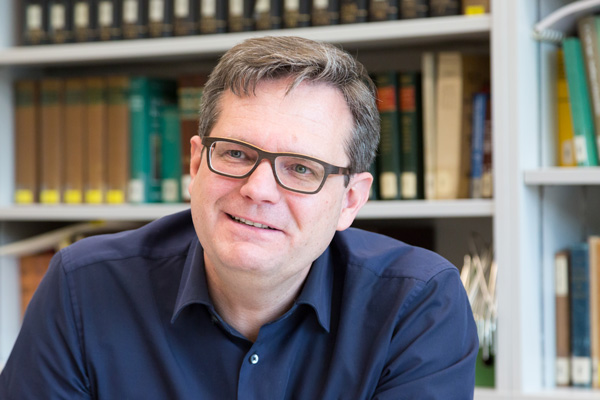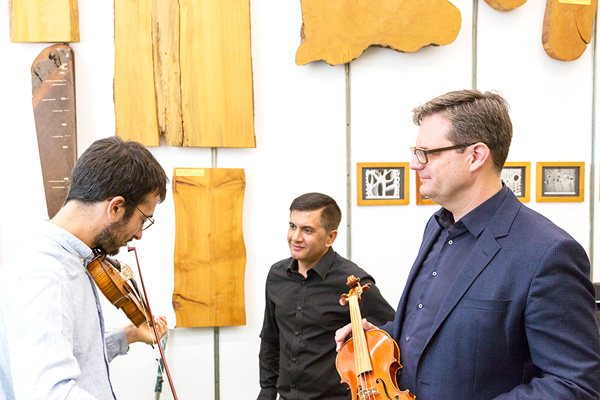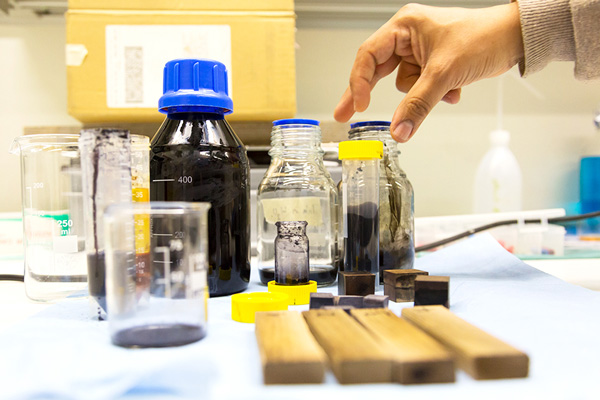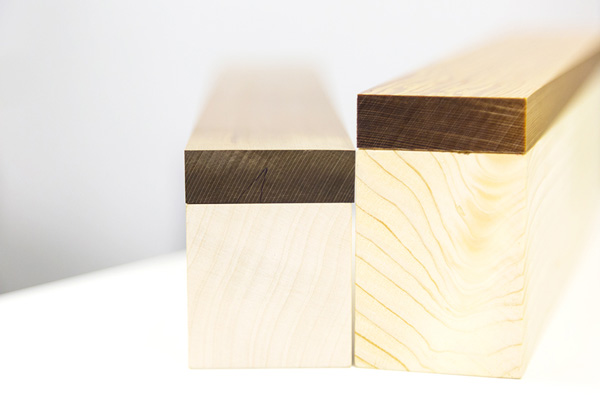
When Swiss spruce turns into something like ebony
How a spin-off of ETH Zurich and EMPA strikes new chords in string instruments, why this helps the tropical forests and what connects the funding of spin-off companies to bathtubs.
Two violins are placed on the table. Next to it, an elegant guitar sits in its stand. Components for clarinets and oboes are placed next to each other on racks. And no, we are not inside a musical instrument shop or in the rehearsal room of a school of music. We find ourselves at the ETH Zurich Hönggerberg campus inside the office of Oliver Kläusler, wood technologist and CEO of the start-up company Swiss Wood Solutions AG. What is displayed on the table and on the shelves is the result of a smart business idea and, at the same time, the answer to a sustainability problem. «It all started with a talk over coffee five years ago,» Oliver Kläusler tells us as we sit down with him and his business partner Munish Chanana as well as with the luthier Gaspard Clerc.
«In five years,
we will be an expanding SME
in Switzerland and have
a branch in North America.»
Oliver Kläusler
Back then, Oliver Kläusler headed a research group at the Chair for Wood Technology at ETH Zurich, where the qualified luthier Gaspard Clerc was writing his bachelor thesis in wood technology. «We started talking during a coffee break and when we spoke about musical instruments Gaspard told me that it was becoming more and more difficult for instrument makers to find tropical timber for the fingerboards and tailpieces of string instruments. They were running out of quality ebony, as the tree population was decreasing rapidly due to decades of overuse. What was needed was an alternative that had the quality of ebony and was sustainable at the same time.» This discussion generated the idea that domestic timbers such as spruce, beech or maple could be altered technologically in such a way that they received the density, hardness and sound characteristics of ebony. By this, domestic wood from sustainable forestry could thus become a valuable quality product for instrument makers and would at the same time solve the sustainability problem. Supported by the timber research institutes of ETH Zurich and EMPA in Dübendorf Oliver Kläusler and his team colleague Walter Sonderegger started their first attempts using the traditional timber technology of compression. Hereby, the wood is condensed in a press under extreme pressure. The results of their experiments were promising.
«Without this contribution
by the EU we might have
had to stop.»
Munish Chanana
They managed to compress domestic timbers by means of skilful modifications of the press method in such a way that their quality came close to the one of ebony. Gaspard Clerc, who has good connections within the instrument maker scene, showed the timbers to several luthiers and they showed an interest. «Luthiers had been looking for alternatives to ebony for some time, and not only for technical or commercial reasons. They are also worried about their trade’s reputation. Musicians, as artists, feel committed to the good cause and do not want to be connected to the destruction of tropical forests simply because the instrument makers use ebony for the fingerboards of violins, violas and celli,» Gaspard Clerc explains.
Of procedures, secrets, violins and violas
However, the two of them had not yet reached their goal. There was still the problem of the so-called spring-back effect. Compressed timber swells back into its original form when it gets wet. Even minimal changes in humidity suffice and wood starts to expand. On top of this problem, there were the aesthetic requests put forward by the luthiers. Fingerboards for string instruments were supposed to be as dark as ebony; domestic timbers, unfortunately, have light colours. It was time that Oliver Kläusler took his colleague at the institute, the chemist Munish Chanana, on board. As the feedbacks from the luthiers had been encouraging, Oliver Kläusler and Munish Chanana submitted a research proposal to the Gebert Rüf Stiftung. The objective of their application to this private funding agency was to find a way to stabilise the structure of densified wood and to develop a procedure that turned domestic timbers into premium quality timber for instrument manufacturing. For about 24 months, the team of Kläusler and Chanana conducted research and experiments and always remained in close cooperation with the instrument makers. Then, they made the breakthrough. Munish Chanana had succeeded in developing a technique and manufacturing method that turned domestic timber into «ebony». The timbers are treated in a liquid bath prior to compression. The formula of the bath and the compression technique are the keys to the procedure and therefore a secret. However, Munish Chanana tells us a bit about what matters. «You have to understand the chemistry, structure and physics of wood. By means of the deliberate modification of the distinct chemistry of the wood the natural structure is stabilised in such a way that the wood can no longer spring back.
«What we are missing in Switzerland
are funding tools that offer
substantial amounts of funds paid
directly to the start-ups themselves.»
Oliver Kläusler
During the compression inside the press the physical parameters humidity, temperature and pressure are then attuned such that the result is the exact material we have today.» It was now time to transfer this knowledge to society. In 2016, Oliver Kläusler and Munish Chanana, together with colleagues, founded the company called Swiss Wood Solutions AG as a spin-off of ETH Zurich and EMPA in Dübendorf. In the basement of the ETH institute, they started producing timbers for fingerboards and tailpieces for violins in small quantities. By now, Gaspard Clerc was writing his dissertation at the Technical University in Munich and he used his good connections to convince some luthiers to work with the new material. They were enthusiastic about the result. It turned out that compressed spruce conveyed sound even faster than ebony and made the instrument sound purer and could be processed in a more precise manner. Musicians were also delighted by this new material that its inventors called «Sonowood». More and more violin and viola soloists had their worn ebony fingerboards and tailpieces replaced by compressed spruce or maple. There was an increasing demand and Swiss Wood Solutions could have sold more timbers than they were able to produce in their basement at ETH Zurich under laboratory conditions.
Of bathtubs, hard times and the deficits of spin-off funding
Barely one year after the founding of their spin-off, Oliver Kläusler and Munish Chanana had reached a milestone in the development of their product. Now, they initiated the commercialisation. «We ordered a large production machinery which will be installed at EMPA in Dübendorf at the end of August 2019. It will allow us to produce at a greater scale, both with regard to the component geometry as well as the number of components,» Oliver Kläusler explains. However, there was yet another obstacle. At the time being, the procedure only worked for the production of timber parts no larger than 30 to 40 centimetres in small quantities.
«Not only universities conduct research.
Start-ups have research knowledge
as well and have to conduct
development.»
Munish Chanana
It was time for the upscaling process; yet, additional research and development tasks were needed. «It is by no means trivial to achieve something on a centimetre scale and then make it work on a metre scale as well. There is major process knowledge and application research behind it,» says Munish Chanana. Swiss Wood Solutions needed another source of capital in order to fund the additional, substantial research and process development effort and did find it, at the last minute, with the «SME Initiative»of the EU Research Funding Programme Horizon 2020. By means of this instrument, the EU supports innovative SMEs to launch novel and promising products. Munish Chanana handed in his proposal in mid-October 2017, shortly before Christmas Swiss Wood Solutions received the confirmation: 1,53 million euros for the duration of two years. «Without this contribution by the EU we might have had to stop,» Munish Chanana considers and addresses a problem that many Swiss start-ups are struggling with – the funding of the «last mile». Usually it takes many years until a spin-off actually makes money with its product. In between, there are phases that require new funds again and again in order to further develop the product. Oliver Kläusler compares these phases to a bathtub. «In the beginning, we filled the bathtub with founding capital. But as soon as the spin-off starts its work, you pull the plug. Water is running out for salaries, social security contributions, material and much more. But the water tap is turned off. No water is running into the bathtub, as you have not yet sold anything. The pressure to proceed quickly is immense.» Funding programmes may bridge these hard times by making sure that the bathtub is not running out of water before the water tap can be opened. This kind of spin-off funding works very well in many countries, but not in Switzerland. Oliver Kläusler describes his experiences as follows: «On the one hand, spin-off funding in Switzerland is very much in the public eye. There are many contact points, such as Venture Lab and others. You then receive coaching support or funds from individual small pots between 1,000 and 10,000 Swiss francs. This is very helpful and all well. However, on the other hand, what we are missing in Switzerland compared to international conditions are funding tools that offer substantial amounts of funds paid directly to the start-ups themselves so that they can pay the salaries and development costs during the frequently long development phases. One could attach conditions to these funds, they are not just for fun. But this would probably be a kind of economic promotion that is not desired politically in Switzerland at the moment.» Munish Chanana confirms this by stating, «Not only universities conduct research. Start-ups have great research knowledge as well and have to conduct development.
«Musicians do not want
to be connected to the destruction
of tropical forests.»
Gaspard Clerc
They need this funding support. The United States, China and Germany are much more advanced in this matter.» Actually, the two company founders have already received attractive offers to move their company to the Black Forest region in Southern Germany or to China. A Chinese intermediary, who frequently visits start-up events in Switzerland, recently presented the prospect of up to 10 million US dollars as start-up capital to Swiss Wood Solutions if the company with all its knowhow would move to China. However, moving the company is off the cards for both CEOs at this point. The next step is to enlarge the product range with the new production centre at EMPA in Dübendorf. Instrument manufacturing serves as the door opener. Next to fingerboards, tailpieces for string instruments and guitars, components for clarinets and oboes and claviatures for keyboard instruments, the product catalogue shall one day also comprise real wood surfaces for furniture and parquet flooring. At the end of our talk, we ask Oliver Kläusler where he sees their start-up five years from now. He thinks about this for a moment, while Gaspard Clerc and Munish Chanana carefully place the two violins back into their cases. Then, he summarises the vision of Swiss Wood Solutions in three sentences: «In five years, we will be an expanding SME in Switzerland. We will have a branch in North America where we modify North American timber from sustainable forestry on site and sell it there. And we will already contemplate establishing a third branch in Asia or Africa.»
Interview with Oliver Kläusler
Munish Chanana
Munish Chanana studied Chemistry at the Münster University and later received his PhD from the Max Planck Institute of Colloids and Interfaces in Potsdam. Thereafter, he worked for several years as a nanoscience researcher at various European universities and research institutes. Prior to his engagement at Swiss Wood Solutions, he led the research group of Hierarchical Nano-Bio Materials at the Institute for Building Materials at ETH Zurich and worked on his habilitation dissertation for the University of Bayreuth. Munish Chanana is Co-founder and Head of R&D of Swiss Wood Solutions AG.
Oliver Kläusler
Oliver Kläusler studied Wood Science and Technology at the Universität Hamburg and wrote his thesis at ETH Zurich. Subsequently, he worked as an R&D engineer and project manager in the wood industry in Switzerland, the Czech Republic and the United States. He is the main inventor and developer of the production technology for two Beaufort products made of wood and aluminium for the interior of Audi cars. He then ran a research group for Applied Wood Science and Technology at Empa in Dübendorf and at ETH Zurich. Oliver Kläusler is Co-founder of Swiss Wood Solutions AG and its first CEO.
SME Instrument
SME Instrument is a funding instrument of the EU that supports highly innovative Small and Medium-sized Enterprises to develop novel products ready for the market. Its main goal is to help promising innovations reaching market maturity and thereby to create growth and jobs. The SME Instrument is funded and administered within the scope of the EU Framework Programme for Research and Innovation, Horizon 2020.








